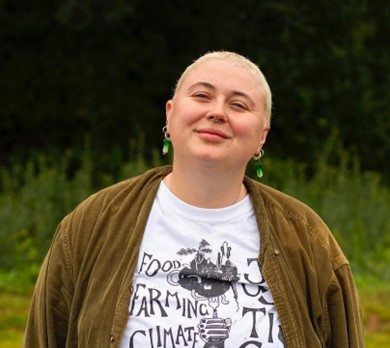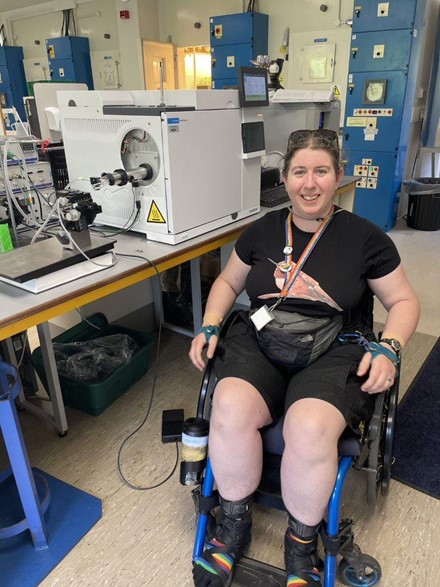Celebrating Disabled Scientists in Plant Science
Science might start with data, but it grows through people who bring it to life! In this article, we meet two plant scientists, Dr. Emily May Armstrong (they/them) and Dr. Kelsey Byers (any/all pronouns), who are reimagining what plant science can evolve into: more open and welcoming for people of all abilities, backgrounds and lived experiences. Their journeys exhibit how the passion for science alongside resilience and community care can shape a meaningful path in science.
 Emily May Armstrong: Growing Science Beyond the Lab
Emily May Armstrong: Growing Science Beyond the Lab
Dr. Emily May Armstrong is a Postdoctoral Research Assistant, at the University of Glasgow, whose works intersect science, community, and art. Emily’s experiences were also featured in a previous plantae blog post. As a multidisciplinary plant biologist, their work is not confined to lab space, but spans across urban gardens, seed libraries, engaging with the community through performances and experimental sound work. In their words, “Where there’s plants and community, I’m there!”
Emily’s journey into science started as a personal exploration. Living with Hypermobile Ehlers Danlos Syndrome, a genetic condition that affects the connective tissue, they initially went into genetics to better understand their health condition. Yet, it was the undergraduate lecture by Prof Tracy Lawson in 2013 that laid their path in plant science, “I was rapt” shares Emily. “It’s been all plants all of the time ever since…”
Emily describes disability as a perspective that broadens their view – one that helps them draw connections between botany, queer ecologies, and disability advocacy. They write “Disability forces you to take a macroscopic approach to life”, referring to ecological theorist Donna Haraway’s concept of ‘tentacular thinking’ – which suggests every system is interconnected and influences one another. For Emily, this interconnected mindset helps them draw unexpected parallels between lived experiences of marginalized humans and plants, pointing out that both are often overlooked. “It’s impossible to separate health from self, [and that deeply shapes] how I approach working with plants.” This perspective translates into their actions by way of their current work – advising Glasgow Seed Library, supporting research into increasing legume consumption, and running community-led ecological monitoring in urban gardens.
Emily expresses that proactive not reactive inclusivity is needed besides clear communication and openness to gentle correction for making science more accessible. “Navigating disability and research can be really challenging – but it is possible!” they say.
Their unconventional science communication style reflects their mission of positioning scientific knowledge in familiar ways. From converting the genetic and circadian data of Arabidopsis into sounds, to telling stories of salt tolerance, or circadian rhythm, they bring plant science to life outside of academia. “[These methods] get people thinking about plants…. A non-expert is much more likely to have access to poetry, sound, and stories than they are to [a lecture]”, shares Emily.
Their journey has not been without setbacks. In 2023, while visiting Arches National Park after being invited to speak at a conference by the American Phytopathological Society, Emily suffered a severe leg injury which complicated their existing health. The recovery was long and difficult. “I tried to embody a plant – moving slowly and deliberately, finding sunshine, being realistic with my limits…”, they recall. Probably this resilience inspires them to relate to a plant, Herb Robert (Geranium robertianum), a native geranium “… little wildflower that grows in the smallest of cracks and strangest of places…. It’s resilient, persistent, and ubiquitous” says Emily “It might not be the fanciest or most sought after, but it knows how to survive in a tough situation”
Now, at the School of Molecular Biosciences in University of Glasgow, Emily is piloting an Inclusive Leadership model, which encourages collective effort to create a welcoming and mindful community in academia. “We’re stronger and more resilient when we are diverse,” they note. You can learn more about their inclusive leadership model here and in their pre-print. Their philosophy is grounded in a simple yet strong belief that, “Science doesn’t happen [only] in laboratories. Everyone is already a scientist – the painter, the bird watcher, the community gardener, the musician….” “Science is the deep, innate curiosity we’re all born with.”
To read more about Emily’s work visit their personal blog. Their social media handle on x: @emilyxarmstrong
 Kelsey Byers: The Scent of Persistence
Kelsey Byers: The Scent of Persistence
Dr. Kelsey Byers is an evolutionary chemical ecologist, whose fascination with plants began during their childhood, walking through the fields of New England with a deck of cards identifying edible and poisonous native flora. “I used to substitute my dinner vegetable serving for a salad made of edible weeds!”, they reminisce.
That early affinity for plants has now unfolded into a career in evolutionary plant biology. Today, Kelsey leads the Byers Lab at the John Innes Centre, a research institute with international excellence in plant and microbial science in Norwich, UK. Their research explores how floral scent influences animal pollination in species like Mimulus (monkeyflowers), Gymnadenia (orchids), and Brassica. “Self-pollinating species produce a higher diversity of [scents] than bee-pollinated species”, they write, sharing their ongoing-curiosity with scent diversity in the Mimulus species. As a multiply disabled, multiply queer scientist, Kelsey brings their lived experience into their research and advocacy.
Outside lab space, Kelsey also actively advocates to make plant-science more accessible for disabled researchers in field settings and shares they are excited to see movements happening in this front. “Glad to see folks are finding my advocacy work and suggestions helpful in designing their own courses and research work”, writes Kelsey.
One of the greatest challenges they share is dealing with the assumptions made by colleagues about their competence, ability, and dedication, given the time they dedicate to outreach. “Sometimes it’s micro behaviors and microaggressions” they say, “anything from [casual misgendering], jokes about “speed limits” as I wheel my wheelchair, to being invited to [an inaccessible event without checking first]”. These experiences can be difficult, Kelsey admits. “I rely on self-care and doing pleasurable activities like birdwatching [and] speaking with colleagues who understand.”
Mentorship and representation are central to their mission. A student with a similar medical condition once reached out to thank Kelsey for showing that someone living with similar health conditions could succeed as a scientist. “As someone who didn’t have any role models as I “grew up” as a scientist, this really struck my heart”, writes Kelsey.
In difficult times, as they mention, “incredible stubbornness,” together with passion for their research species keeps them going. Kelsey recalls a time in grad school, when they considered quitting PhD until unexpectedly spotting their study species growing in the wild. ” I was overjoyed to see it” One friend said, “that’s why you need to stick with your PhD – you love it!”
Kelsey believes that shifting perspectives from ‘can’t’ to ‘can’ be the beginning of change in academia. “Assuming a disabled person can do a task with the right reasonable adjustments rather than assuming incapability”. On an institutional level, that means acknowledging that those adjustments are possible and are reasonable.
When asked about small actions that people can do to make STEM more inclusive, Kelsey calls on senior scientists to show vulnerability. “Comfort grows from that shared vulnerability”, they say, adding that senior scientists could advocate for ECRs and address inequities in academia. “It’s exhausting to always have to stand up for ourselves. Having someone say, ‘Hey, that’s not okay,’ lifts a huge weight.”
If academia were an ecosystem, Kelsey sees themselves as a mycorrhiza – not really visible yet trying to connect everyone together. “[I] nourish those I work with [so they] develop to their greatest potential!”
True to that vision, Kelsey leverages their role to advocate for inclusivity, to make fieldwork more accessible for disabled scientists. Their efforts have been recognized with awards like the DO-IT Trailblazer; but most importantly it inspires us to envision a more welcoming scientific community!
To read more about Kelsey’s work visit their personal blog. Their social media handle on x: @plantpollinator
Growing a More Inclusive Science
Emily and Kelsey may differ in their research interests or approaches, but they share a common purpose – redefining who belongs in science and what it can look like when all axes of diversity are celebrated. Let’s keep tending to that vision of making science more welcoming, more human and more whole, by embracing the differences!
______________________________________________
About the Author
Malini Muthu Karpagam
Malini is a postdoctoral associate at the Plant Physiology Arts Community Engagement (PLACE) lab at Smith College, Massachusetts, and a 2025 Plantae Fellows. During her Ph.D., she explored the impact of high-temperature stress on rice, and her transition to forest trees has expanded her understanding of plant physiology across ecosystems. Outside research, Malini teaches, creates science blurbs, writes blog posts, and enjoys working on art projects and traveling. You can find her on X: @malini_muthuraj.



